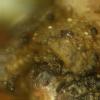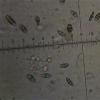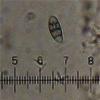
13-04-2013 11:45
 Yannick Mourgues
Yannick Mourgues
Bonjour à tous.Toutes petites sphères noires à

09-04-2013 08:38
Stefan BlaserHello everybody I would appreciate any advice on

10-04-2013 08:48
Hi all,Someone gave me this fungus found on Saroth

09-04-2013 22:18
Esquivel-Rios EduardoHi All.Here a ascomycete associated to leaf spots,

09-04-2013 05:58
 John Plischke
John Plischke
I was at work over the weekend and I fixed a water

06-04-2013 16:34
Roland LabbéBonjour !Voici une pézize que nous croyons être
Sur Squamarina cartilaginea
Yannick Mourgues,
13-04-2013 11:45
 Bonjour à tous.
Bonjour à tous.Toutes petites sphères noires à péridium rugueux. Pas d'Ostiole observé.
A l'intérieur, des spores triseptées de dimensions : 9,3-13,7x3,7-5,8 um Q=1,9-2,9. Hyalines à brun très clair.
Pas d'asques observés. Juste un demi-asque bituniqué... Les ascomes semblent un peu vieux.
Mais à tout hasard... Une idée Alain ?
Yannick
Alain GARDIENNET,
13-04-2013 11:56
Re : Sur Squamarina cartilaginea
Oui, j'ai une idée car c'est un asco que je connais bien.
C'est un Capronia. Dommage que tu n'aies pas d'asque, car leur forme est caractéristique du genre.
Je te recontacte car je n'ai pas mes notes près de moi.
Alain
C'est un Capronia. Dommage que tu n'aies pas d'asque, car leur forme est caractéristique du genre.
Je te recontacte car je n'ai pas mes notes près de moi.
Alain
Christian Lechat,
13-04-2013 12:16

Re : Sur Squamarina cartilaginea
normalement il devrait y avoir un voil autour des spores
Christian
Christian
Yannick Mourgues,
13-04-2013 12:31

Re : Sur Squamarina cartilaginea
Exact. Il y a une enveloppe gel de moins de 2 um d'épaisseur.
Y
Y




